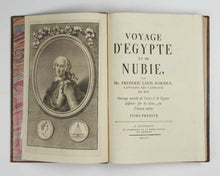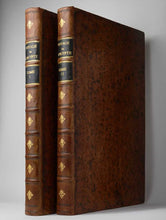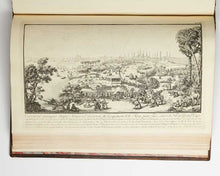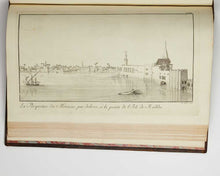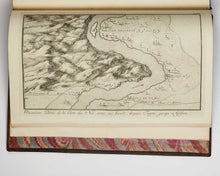
NORDEN, Frederik Ludvig. Voyage d’Égypte et de Nubie, par Mr. Frederic Louïs Norden, capitaine des vaisseaux du roi. Ouvrage enrichi de cartes & de figures dessinées sur les lieux, par l’auteur même. Copenhagen: L’Imprimerie de la Maison Royale des Orphelins. 1755.
Two vols, large folio (460 × 320 mm). Contemporary mottled calf, recently rebacked, marbled endpapers; pp. I: [lx], 104; II: [103]-288; engraved frontispiece, engraved portrait, and 159 plates as called for, with engraved vignettes and initials; extremities a little rubbed; one plate with a short marginal tear (repaired), very occasional light spotting, otherwise a remarkably clean and fresh copy; all plates with full margins (none cut down and joined to form folding plates, as is often the case).
First edition of this pioneering and celebrated work, a cornerstone of Egyptology, containing the earliest systematic European descriptions of Egypt and its antiquities.
The Danish naval officer Frederik Ludvig Norden (1708-1742) was commissioned by King Christian VI to accompany Count Pierre Joseph le Roux d’Esneval on an expedition to explore the Nile valley and seek a possible route to Ethiopia, imagined as a land rich in gold and natural resources. Norden sailed down the Nile between 1737 and 1738, reaching further south than any European since antiquity, as far as present-day Sudan, where the party was ultimately forced to turn back after being attacked.
Throughout the expedition, Norden kept meticulous notes and produced on-site drawings documenting monuments, landscapes, and daily life – including the first visual and textual accounts of several now-famous Egyptian archaeological sites. The finely executed plates, engraved by the Nuremberg artist and polymath Carl Marcus Tuscher (1705-1751), remain among the most significant visual records of Egypt prior to Denon’s Voyage dans la Basse et la Haute Égypte (1802).
While parts of the narrative retain a picaresque tone typical of eighteenth-century travel literature, Norden’s lasting importance lies in the accuracy and precision of his observation. Predating Napoleon’s French expedition by sixty years, his “drawings of houses, local people, utensils and other objects of the Arab Egyptian household have supplied ethnographers with valuable information” ever since (Buhl, Dal & Colding).
Printed in an edition of two hundred copies for the newly founded Royal Danish Scientific Society, Voyage d’Égypte et de Nubie is notably scarce, especially in such fine condition.
Not in Atabey; see Blackmer 1211 for the 1757 English edition. See Marie-Louise Buhl, Erik Dal and Torben Høick Colding, The Danish Naval Officer Frederik Ludvig Norden. His Travels in Egypt 1737-1738, The Royal Danish Academy of Sciences and Letters, 1986.
#2123156





